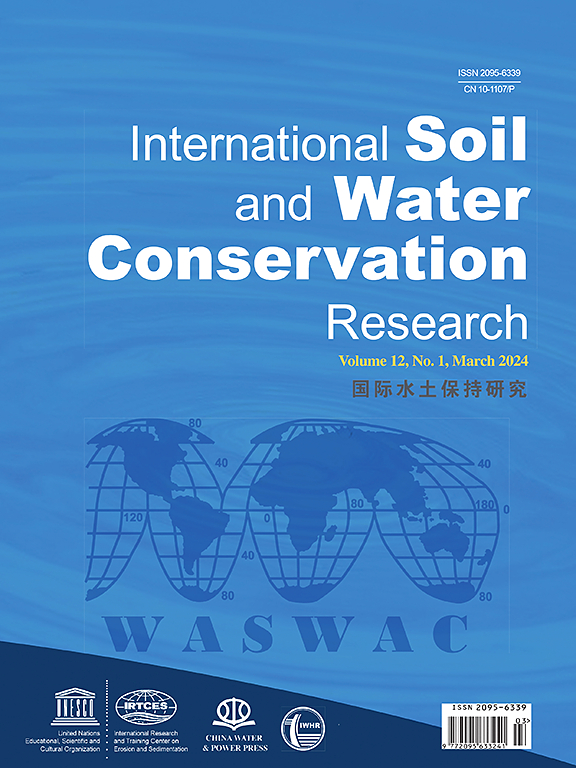An integrated wind erosion model with nonphotosynthetic vegetation (NPV) based on remote sensing
IF 7.3
1区 农林科学
Q1 ENVIRONMENTAL SCIENCES
International Soil and Water Conservation Research
Pub Date : 2025-05-09
DOI:10.1016/j.iswcr.2025.05.001
引用次数: 0
Abstract
Nonphotosynthetic vegetation (NPV) including dormant vegetation and plant residues plays important roles in wind erosion control. However, the effects of NPV on wind erosion have not been fully considered at regional scales, which led to large uncertainties in wind erosion simulations. With the development of NPV remote sensing technology and drag partition schemes, an integrated wind erosion model with nonphotosynthetic vegetation monitoring has become possible. Here, we integrated a wind erosion model and a NPV monitoring method and simulated wind erosion processes in the desert steppe (DS) of Inner Mongolia and the Mu Us Sandy Land (MU). After we nested NPV monitoring in the wind erosion model, an integrated model was developed, by which total vegetation cover and the corresponding frontal area were derived. Then, the aerodynamic parameters of the roughness elements were extracted using the Raupach drag partition scheme. The integrated model provided more accurate simulated wind erosion results compared to the original model, and the relative error of the simulated results by the integrated model was reduced by 61 %. NPV played an important role in wind erosion control, especially in non-growing seasons and in semi-arid regions. Finally, we discussed the potential uncertainties in wind erosion simulations induced by vegetation parameters. Our study provides a new insight into wind erosion simulations and the simulation results provide support for land conservation.
基于遥感的非光合植被综合风蚀模型
非光合植被(non - photosynthetic vegetation, NPV)包括休眠植被和植物残体,在风蚀控制中起着重要作用。然而,在区域尺度上,NPV对风蚀的影响尚未得到充分考虑,导致风蚀模拟存在较大的不确定性。随着NPV遥感技术和阻力分区方案的发展,集成非光合植被监测的风蚀模型成为可能。本文将风蚀模型与NPV监测方法相结合,模拟了内蒙古荒漠草原和毛乌素沙地的风蚀过程。将NPV监测嵌套到风蚀模型中,建立了一个综合模型,通过该模型可以得到植被覆盖总量和相应的锋面面积。然后,采用Raupach阻力分割法提取粗糙度单元的气动参数;与原始模型相比,综合模型提供了更精确的风蚀模拟结果,综合模型模拟结果的相对误差降低了61%。净现值在控制风蚀方面发挥了重要作用,特别是在非生长期和半干旱区。最后,讨论了植被参数对风蚀模拟的潜在不确定性。该研究为风蚀模拟提供了新的思路,为土地保护提供了理论依据。
本文章由计算机程序翻译,如有差异,请以英文原文为准。
求助全文
约1分钟内获得全文
求助全文
来源期刊

International Soil and Water Conservation Research
Agricultural and Biological Sciences-Agronomy and Crop Science
CiteScore
12.00
自引率
3.10%
发文量
171
审稿时长
49 days
期刊介绍:
The International Soil and Water Conservation Research (ISWCR), the official journal of World Association of Soil and Water Conservation (WASWAC) http://www.waswac.org, is a multidisciplinary journal of soil and water conservation research, practice, policy, and perspectives. It aims to disseminate new knowledge and promote the practice of soil and water conservation.
The scope of International Soil and Water Conservation Research includes research, strategies, and technologies for prediction, prevention, and protection of soil and water resources. It deals with identification, characterization, and modeling; dynamic monitoring and evaluation; assessment and management of conservation practice and creation and implementation of quality standards.
Examples of appropriate topical areas include (but are not limited to):
• Conservation models, tools, and technologies
• Conservation agricultural
• Soil health resources, indicators, assessment, and management
• Land degradation
• Sustainable development
• Soil erosion and its control
• Soil erosion processes
• Water resources assessment and management
• Watershed management
• Soil erosion models
• Literature review on topics related soil and water conservation research
 求助内容:
求助内容: 应助结果提醒方式:
应助结果提醒方式:


